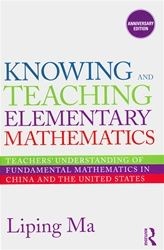Four Properties – to ensure a profound understanding of fundamental mathematics
Liping Ma (2010) believes in four properties in teaching and learning which sum up the way in which a teacher’s profound understanding of fundamental mathematics can be represented in the classroom. By this, Ma means a teacher will demonstrate the four properties and if this is successful, he or she has a profound understanding of fundamental mathematics.
– If you are unsure about what this is – profound understanding of fundamental mathematics – scroll to the bottom to read quotes extracted from Liping Ma’s ‘Knowing and Teaching Elementary Mathematics’ (2010). This may aid your understanding of the Four Properties in this post.
The first, connectedness, occurs when a learner has the intention of making connections between mathematical concepts and procedures. In pedagogical terms, the teacher will prevent the learning from being fragmented and instead, learners will develop the ability to make connections between underlying mathematical concepts that link.
The second property, multiple perspectives, is practised when a learner is able to take into account various perspectives when thinking in a mathematical way. This includes addressing pros and cons of all different viewpoints considered. In pedagogical terms, the teacher provides opportunity for their learners to have a flexible way of thinking and understanding concepts in maths.
Thirdly, basic ideas, is a way of thinking about maths in terms of equations. Ma refers to basic ideas as, “simple but powerful basic concepts and principles of mathematics” (2010, p. 122). Ma suggests, when practising the property ‘basic ideas’, learners are guided to conduct ‘real’ maths activity rather than just being encouraged to approach the problem. I suggest this means if a teacher is effectively implementing this property, he or she will be not just attempting to motivate the learners to approach the maths work, but instead, providing a solid and secure guide to the learners understanding the maths themselves.
The forth and final property, longitudinal coherence, is when a learner does not have a limit or boundary of knowledge. In other words, it is not possible to ‘categorise’ the learner or identify the learner as working at a specific level or stage in maths. Instead, he or she has achieved a holistic understanding of maths – a fundamental understanding. In pedagogical terms, Ma suggests a teacher who has achieved a profound understanding of mathematical understanding is one who is able to identify on demand the learning that has been previously obtained and will be learned later. Subsequently, the teacher will lay the fundamental maths as a foundation for later learning.
A few quotes extracted from Liping Ma’s Knowing and Teaching Elementary Mathematics (2010) that I feel define and summarise profound understanding of fundamental mathematics…
“The term ‘fundamental’ has three related meanings: foundational, primary, and elementary.”
– Ma (2010, page 120)
“By profound understanding I mean an understanding of the terrain of fundamental mathematics that is deep, broad and thorough. Although the term ‘profound’ is often considered to mean intellectual depth, it’s three connotations , deep, vast, and thorough, are interconnected.”
– Ma (2010, page 120)
“As a mathematics teacher one needs to know the location of each piece of knowledge in the whole mathematical system, its relation with previous knowledge.”
– Tr. Mao (2010, page 115)
“I have to know what knowledge will be built on what I am teaching today.”
– Tr. Mao (2010, page 115)
References
Ma, L. (2010) Knowing and Teaching Elementary Mathematics 2nd edn. New York: Routledge. Pages 115-122.


